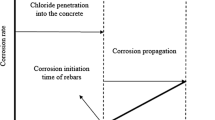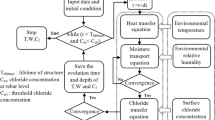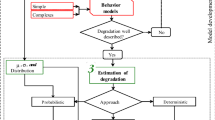Abstract
The probability distributions of the critical threshold chloride concentration C cr, the chloride diffusion coefficient D, and the surface chloride concentration C s are determined based on the collected natural exposure data, and the probability estimation of reinforcement depassivation in concrete is presented using Monte-Carlo simulation. From sensitivity analysis of mean value for c cr, c s, and D on the depassivation probability of reinforcement, it is found that c cr, c s, and D respectively has the greatest, smaller, and the lowest effect on the probability of depassivation. Finally the effect of stress state of concrete on the reinforcement depassivation probability is analyzed. It is found that the influence of stress state becomes apparent as exposure time increases.
Similar content being viewed by others
References
Liang M T, Wang K L, Liang C H. Service Life Prediction of Reinforced Concrete Structures[J]. Cement and Concrete Research, 1999, 29: 1 411–1 418
C Alonso, C Andrade, M Castellote, et al. Chloride Threshold Values to Depassivate Reinforcing Bars Embedded in a Standardized OPC Mortar[J]. Cement and Concrete Research, 2000, 30: 1 047–1 055
Mark G Stewart, David V Rosowsky. Time-dependent Reliability of Deteriorating Reinforced Concrete Bridge Decks[J]. Structural Safety, 1998, 20: 91–109
G K Glass, N R Buenfeld. The Presentation of the Chloride Threshold Level for Corrosion of Steel in Concrete[J]. Corrasion Science, 1997, 39(5): 1 001–1 013
S Erdogdu, I L Kondratova, T W Bremner. Determination of Chloride Diffusion Coefficient of Concrete Using Open-circuit Potential Measurements[J]. Cement and Concrete Research, 2004, 34: 603–609
HaWon Song, ChangHong Lee, KiYong Ann. Factors Influencing Chloride Transport in Concrete Structures Exposed to Marine Environments[J]. Cement & Concrete Composites, 2008, 30: 113–121
Anders Lindvall. Chloride Ingress Data from Field and Laboratory Exposure-Influence of Salinity and Temperature[ J]. Cement & Concrete Composites, 2007, 29: 88–93
T Maheswaran, J G Sanjayan. A Semi-closed-form Solution for Chloride Diffusion in Concrete with Time-varying Parameters[ J]. Magazine of Concrete Research, 2004, 56(6): 359–366
Mumtaz K Kassir, Michel Ghosn. Chloride-induced Corrosion of Reinforced Concrete Bridge Decks[J]. Cement and Concrete Research, 2002, 32(1): 139–143
Konin, R Franfois, G Arliguie. Penetration of Chlorides in Relation to the Micro Cracking State into Reinforced Ordinary and High Strength Concrete[J]. Materials and Structures, 1998, 31: 310–316
Zhao S C, Gong J X, Shui J F. Test of Chloride Diffusion Rules in Concrete at Tidal Zone Under Flexural Load[J]. China Journal of Highway and Transport, 2007, 20(4): 76–82 (in Chinese)
Philip D Cady, Richard E Weyers. Deterioration Rates of Concrete Bridge Decks[J]. Journal of Transportation Engineering, 1984, 110(1): 34–44
K Takewaka, S Mastumoto. Quality and Cover Thickness of Concrete Based on the Estimation of Chloride Penetration in Marine Environments[C]. In: (3rd Edition), ACI-SP 109-117, Concrete in Marine Environment, Detroit 1988: 381–400
Gjφrv, OE Venneslandφ. Diffusion of Chloride Ions from Seawater into Concrete[J]. Cement Concrete Research, 1979, 9: 229–238
Liam KC, Roy SK, Northwood DO. Chloride Ingress Measurements and Corrosion Potential Mapping Study of a 24-year-old Reinforced Concrete Jetty Structure in a Tropical Marine Environment Research[J]. Magazine of Concrete Research, 1992, 44: 205–215
Mohammed TU, Yamaji T, Hamada H. Chloride Diffusion, Microstructure and Mineralory of Concrete after 15 Years of Exposure in Tidal Environment[J]. ACI Material, 2002, 99: 256–263
Bamforth PB, Price WF. Factors Influencing Chloride Ingress into Marine Structures[C]. In: Dhir RK, Jones MR, editors. Concrete, 1993: 1 105–1 118
Dhir RK, El-Mohr MAK, Dyer TD. Chloride Binding in GGBS Concrete[J]. Cement Concrete Research, 1996, 26: 1 767–1 773
Funahashi M. Predicting Corrosion Free Service Life of a Concrete Structure in a Chloride Environment[J]. ACI Material, 1990, 87: 581–587
Uji K, Matsuoka Y, Maruya T. Formation of an Equation for Surface Chloride Content of Concrete due to Permeation of Chloride[C]. Corrosion of Reinforcement in Concrete. London, Elsevier Applied Science, 1990: 258–267
Kudoh K, Hirotani A, Moriwake A, et al. Study on Durability of a Repaired Concrete Structure in Tokyo Bay[C]. Evaluation and Rehabilitation of Concrete Structures and Innovations in Design. ACI 128, Hong Kong, 1991: 1 293–12 307
S Erdogdu, I L Kondratova, T W Bremner. Determination of Chloride Diffusion Coefficient of Concrete using Open-circuit Potential Measurements[J]. Cement and Concrete Research, 2004, 34: 603–609
P Sandberg, L Tang, A Andersen. Recurrent Studies of Chloride Ingress in Uncracked Marine Concrete at Various Exposure Times and Elevations[J]. Cement and Concrete Research, 1998, 28(10): 1 489–1 503
Olivier Poupard, Abdelkarim Aıt-Mokhtar, Paul Dumargue. Corrosion by Chlorides in Reinforced Concrete: Determination of Chloride Concentration Threshold by Impedance Spectroscopy[ J]. Cement and Concrete Research, 2004, 34: 991–1 000
Fan Z, Yang F, Huang J, et al. Experimental Study on Long-Term Exposure Test of Marine Concrete[J]. Port&Waterway Engineering in China, 2005, (9): 45–57
Byung Hwan Oh, Seung Yup Jang. Effects of Material and Environmental Parameters on Chloride Penetration Profiles in Concrete Structures[J]. Cement and Concrete Research, 2007, 37: 47–53
MDA Thomas, JD Matthews. Performance of PFA Concrete in a Marine Environment-10 Year Results[J]. Cement & Concrete Composites, 2004, 26: 5–20
Sterritt G, Chryssanthopoulos MK. Probabilistic Limit State Modeling of Deteriorating RC Bridge using a Spatial Approach[ C]. Proceedings of the International Conference on Current Trend in Bridge Design, Construction and Maintenance. London, 1999: 518–528
R E Melchers, C Q Li, W Lawanwisut. Probabilistic Modeling of Structural Deterioration of Reinforced Concrete Beams under Saline Environment Corrosion[J]. Structural Safety, 2008, 30: 447–460
Author information
Authors and Affiliations
Corresponding author
Additional information
Funded by National Natural Science Foundation of China (Nos.50908148 and 50925829), Research Project of Ministry of Housing and Urban-Rural Development of China (Nos.2009-K4-23, 2010-11-33), and National Key Technologies R&D Program of China (No.2006BAJ02B04)
Rights and permissions
About this article
Cite this article
Zhang, X., Zhao, Y. & Lu, Z. Probabilistic assessment of reinforcing steel depassivation in concrete under aggressive chloride environments based on natural exposure data. J. Wuhan Univ. Technol.-Mat. Sci. Edit. 26, 126–131 (2011). https://doi.org/10.1007/s11595-011-0183-4
Received:
Accepted:
Published:
Issue Date:
DOI: https://doi.org/10.1007/s11595-011-0183-4




